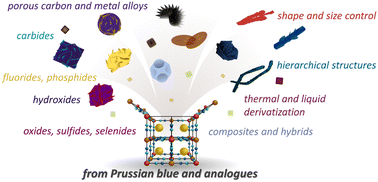Prussian blue and its analogues as functional template materials: control of derived structure compositions and morphologies
Abstract
Hexacyanometallates, known as Prussian blue (PB) and its analogues (PBAs), are a class of coordination compounds with a regular and porous open structure. The PBAs are formed by the self-assembly of metallic species and cyanide groups. A uniform distribution of each element makes the PBAs robust templates to prepare hollow and highly porous (hetero)nanostructures of metal oxides, sulfides, carbides, nitrides, phosphides, and (N-doped) carbon, among other compositions. In this review, we examine methods to derive materials from PBAs focusing on the correlation between synthesis steps and derivative morphologies and composition. Insights into catalytic and electrochemical properties resulting from different derivatization strategies are also presented. We discuss challenges in manipulating the derivatives' properties, give perspectives of synthetic approaches for the target applications and present an outlook on less investigated grounds in Prussian blue derivatives.

- This article is part of the themed collection: Journal of Materials Chemistry A Recent Review Articles


 Please wait while we load your content...
Please wait while we load your content...